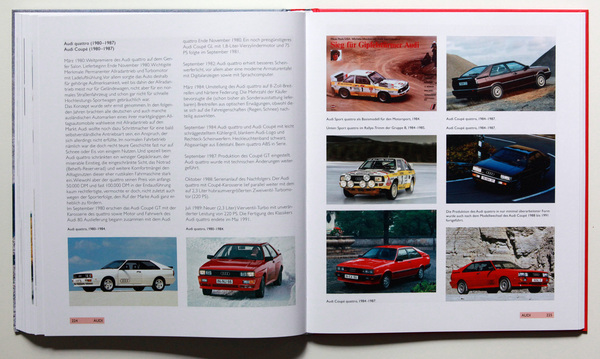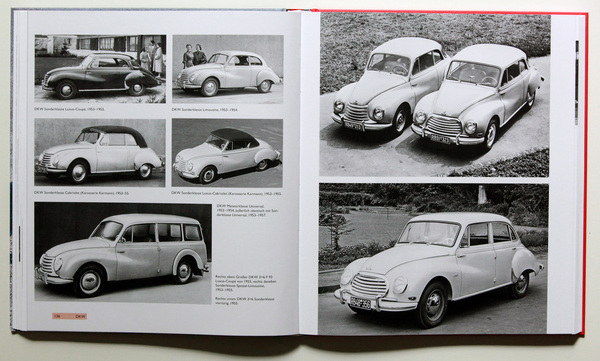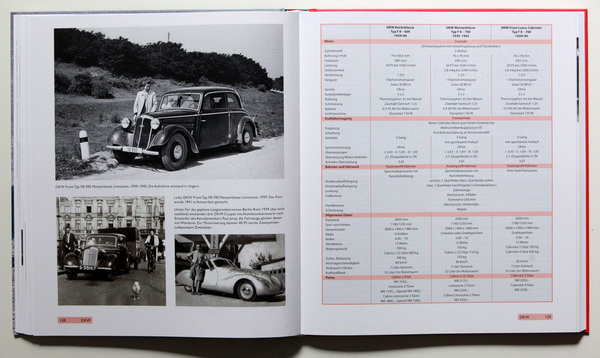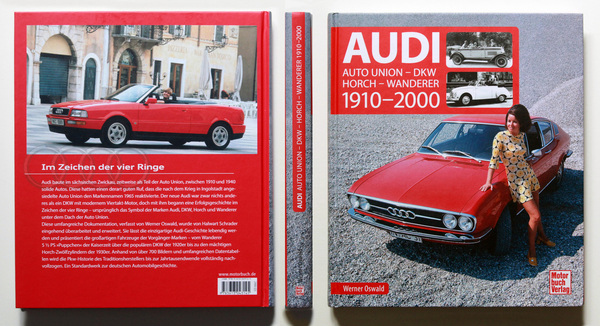"It can be taken for granted that "Audi" is the Latin imperative "hear" and is synonymous with "listen"." So begins the chapter on the revival of the Audi brand in 1965 in my eagerly awaited book entitled "Audi". The attraction of the announcement for me was in the subtitle, because the brands DKW, Horch and Wanderer, which formed the "Auto Union" merger in 1932, were also to be summarized in this typology. There has never been anything like this for Audi history before.

This makes it all the more exciting to read the more than 300 pages of content promised by Motorbuch Verlag under the authorship of "Werner Oswald".
Audi, DKW, Horch, Wanderer, Auto Union and why NSU?
Hardly any other company history of an automobile manufacturer still in existence today is as complex and characterized by ups and downs as that of the four rings. De jure, today's Audi AG goes back to NSU Werke, which was founded in 1873 and merged with Ingolstadt-based Auto Union GmbH to form Audi NSU Auto Union AG in 1969 on the initiative of Volkswagen.
De facto, this was not a merger, as is often succinctly claimed, but rather Volkswagen AG contributed its shares in Auto Union GmbH as a tangible asset in the form of a capital increase to become the majority shareholder in Neckarsulm. When the company was renamed Audi AG in 1985, there was nothing left of NSU; the last NSU - a red Ro 80 - had already rolled off the production line eight years earlier.

Audis were now built by Audi and had four rings at the front. These four rings stood for the aforementioned merger of the Saxon car manufacturers Audi, DKW, Horch and Wanderer to form Auto Union in 1932. In addition to DKW and Wanderer, the Horch brand, founded in 1899 by automobile pioneer August Horch, and the Audi brand, newly founded by him in 1909 after his dismissal, were reunited. Auto Union established itself as the second-largest German automobile manufacturer behind Opel: highly innovative, active in motorsport on all fronts on two and four wheels and on four continents. The beginning of the Second World War and in particular its consequences (almost) drove Auto Union AG, which was deleted from the commercial register in Chemnitz in 1948, into exodus.
Phoenix from the ashes
Some former executives of the former Auto Union AG had gained a foothold in Bavaria and founded a new Auto Union GmbH, which was able to invoke the rights, patents and product samples of the former stock corporation without being associated de jure with the former Auto Union AG. With this maneuver, the company wanted to start building motorcycles and automobiles unencumbered by possible claims from the period before 1945.
The start in Ingolstadt and Düsseldorf was successful with the DKW models until 1957, when a lack of liquidity forced the company to turn to Daimler Benz. Despite the immense investments - including in a new plant in Ingolstadt - the Stuttgart-based company was not happy with the subsidiary. At the latest since the presentation of the last DKW, the F 102, with the two-stroke engine that was considered outdated by the press and customers, the directors of Stern were fed up and sold the new plant (with poorly utilized two-stroke production) to Volkswagen, where they were desperately looking for production capacities and employees.

Actually, the story could have ended here, but some engineers previously sent to Ingolstadt by Mercedes had in the meantime fitted the F 102 with a four-cylinder engine and given it a slight facelift. Success was not long in coming, money was made just one year later, the first Audi and the Audi 100 were crisis savers and money-making machines: The four rings were back and, together with NSU, formed Audi NSU Auto Union AG from 1969. The circle was complete.
Four, five or even six brands
This preliminary remark is so important because Audi's convoluted company history makes it absolutely difficult to write a book about it. It takes a certain amount of basic knowledge on the part of the reader to always know where you are in the history. With Audi, DKW, Horch, Wanderer and Auto Union, there is room for five of the six brands interwoven into Audi's history. NSU is excluded; no vehicles were produced under the Auto Union name before 1945.
It was not until the end of the 1950s that the large DKW models were marketed as the Auto Union 1000, although this does not limit the scope of the work. At 300 pages, it is an exceptionally voluminous volume on the history of the type, the contents of which are not the responsibility of Werner Oswald, but of the well-known automobile historians Halwart Schrader and Eberhard Kittler.
It should be noted that Oswald published two typologies on Audi and Horch in 1979 and 1980, which were pretty much the only literature on Audi history at the time. When asked, the publisher informed us that they did not want to do without the pulling power of Werner Oswald. It is nevertheless surprising that Schrader and Kittler were not named as co-authors. There was too much elaborate addition, over-work and, above all, contribution. The complete DKW and hiker typology is new.
Prepared in a targeted manner ...
This typology is divided into four chapters and covers the brands chronologically in the order Horch, Wanderer, DKW and Audi. Each chapter is provided with an introduction to the company's history and then divided into sub-chapters that present the models of the individual brands as well as other company-relevant facts, anecdotes and background information. As already briefly touched on above, the complex history of the individual brands makes a self-contained presentation extremely difficult.

The chosen form of the treatise on the individual brands is certainly a viable way of dealing with the complexity. Especially in order to be able to make quick comparisons in the countless type tables with their comprehensive technical specifications. Did the Audi Super 90 have the same engine as the Audi 100? Did the Horch 853 have a shorter or longer wheelbase than the Horch 855? This book can provide such answers in a simple and straightforward way and also illustrate them thanks to the rich pictorial material. There are also interspersed sections in which technical achievements or personalities are highlighted and dealt with individually. It is easy to read, the text is written fluently and only in some places is it reminiscent of the rather dry form of expression of Werner Oswald, who wrote more in the style of a police report.
... but not always consistent down to the last detail
Well meant is not always well done. Time and again, connoisseurs of type and company history stumble across factual errors. Often it's the captions: a Horch 670 V12 is very easy to distinguish from a similar-looking Horch 750 with an 8-cylinder engine. The 12-cylinder had to make do without the winged globe as a radiator figure because the company only had the rights to use it on the eight-cylinder engines. Here and there it just tweaks. It is a well-known fact that the so-called "last Horch", an 830 BL built for the then director of Auto Union, was not built by Spohn in Ravensburg as described by Werner Oswald in his Horchbuch published in 1980. The vehicle, which reappeared around 12 years ago, has been in the museum at Audi since 2009 and, as is known, the body was manufactured in Ingolstadt - as shown in many pictures and in some articles.
Admittedly, there are little things that are only immediately noticeable to those in the know, but they will have to swallow hard. Especially as the author duo are very familiar with the company facts. In their abundance, the inconsistencies are not so marginal that they can be overlooked. On the contrary, there are also passages in the text that in no way stand up to the facts.
Contrary to what the book claims, there was never a small series of the Audi 100 for sale as a hybrid "Duo". The author of these lines used two of the prototypes for marketing purposes and is familiar with the Duo story right down to the technical details of its development and marketing. This can be dismissed as a bit of a curmudgeonly comment, but bear in mind that books of this size and standard are used as sources in the automotive history scene.
And who isn't familiar with the sometimes heated discussions on social media channels, where people like to refer to what is written in books. It would be a shame if mistakes had made one or two discussions obsolete. To put it more harmlessly: when in doubt, other sources should be consulted.
Balanced balance
This book provides a comprehensive 300-page history of the Audi, DKW, Hoch and Wanderer brands from 1899 to around 2000, concluding with the first-generation Audi TT. The technical plates provide a comprehensive overview of the models presented with detailed information: especially within a model series or across different generations.

Thanks to the extensive image material, it is always possible to identify a model and its technology. The selection of images is varied, but not always consistent. While the first Audi 100, for example, surprises with countless pictures of US models, this excitement flattens out again with the following Audi 80: no pictures of the US Audi 80, called "Fox" there. You could almost be forgiven for thinking that a little private archive had been reprocessed.
The detailed texts present the complex company history and the associated model diversity in an easily understandable way. The opportunity to follow one of the most diverse model ranges of a German car manufacturer is given here.
The layout follows the publisher's usual pattern. Familiar to all, but a little bland in the long run. But at a price of € 29.90, you shouldn't complain, the book can do a lot, but not everything. You can still get to the bottom of Audi's history.

Bibliographical information
- Title: Audi - Auto Union - DKW - Horch - Wanderer - 1910-2000
- Author: Werner Oswald (completely expanded and comprehensively revised by Halwart Schrader with the assistance of Eberhard Kittler
- Language: German
- Publisher: Motorbuch Verlag
- Edition: 1st edition September 2020
- Format: Hardcover, 230 x 265 mm
- Scope: 304 pages, 400 photos and illustrations
- ISBN: 978-3-613-04314-5
- Price: EUR 29,90
- Buy/Order: Online at amazon.de, online at Motorbuch Verlag or in a good bookshop


























